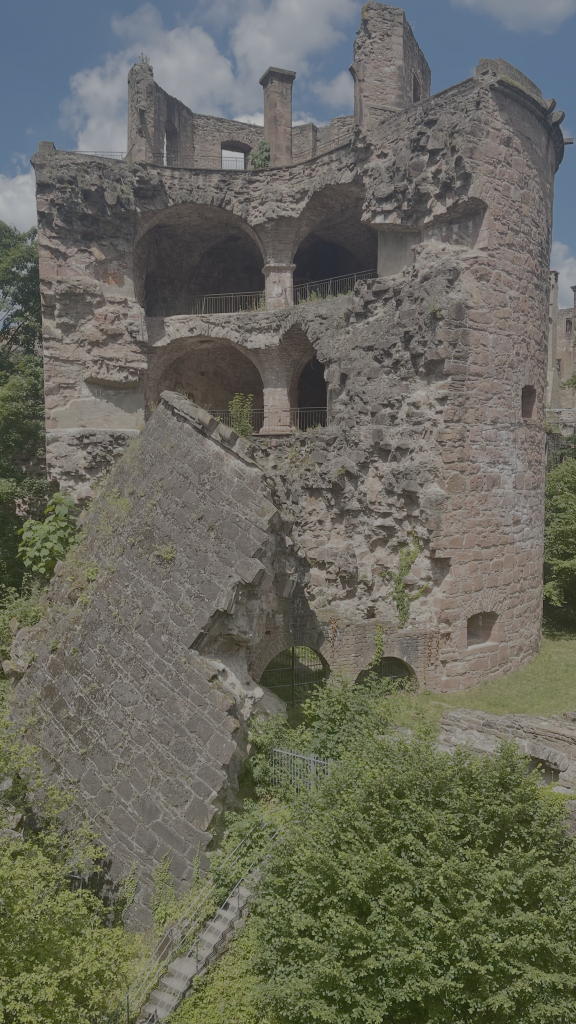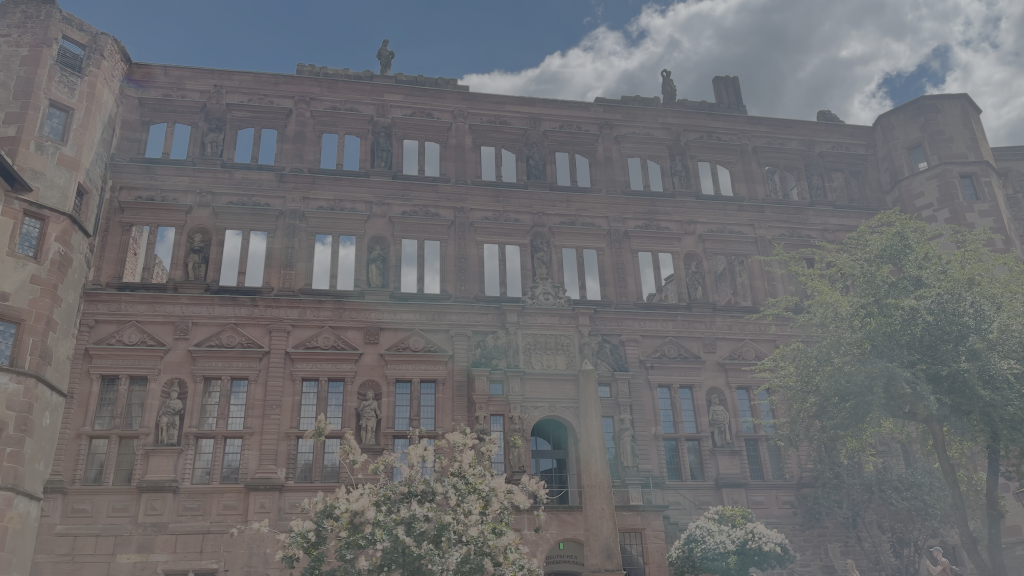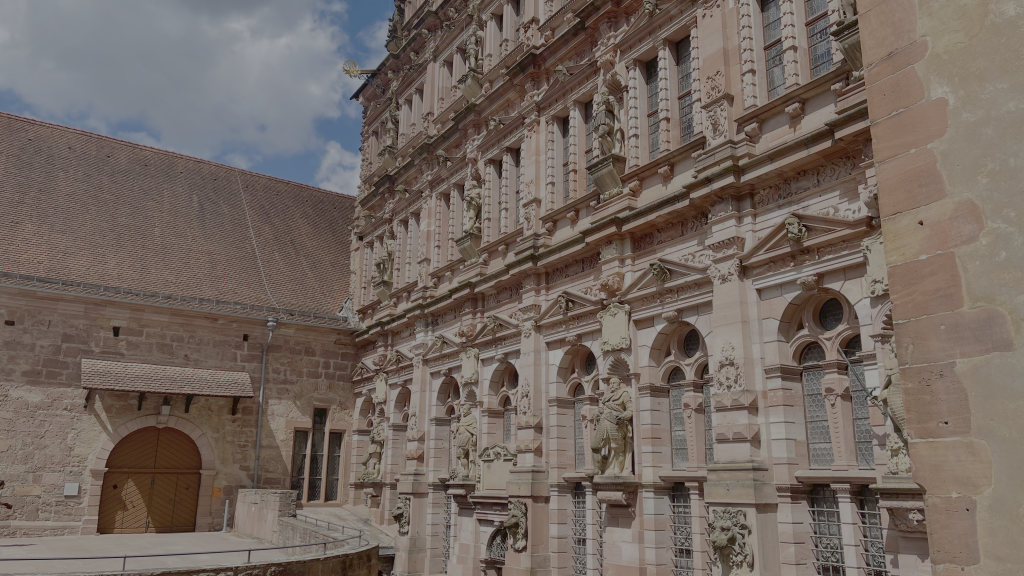In the last blog entry about castles and fortresses, we have mostly discussed the placement of a castle or fortress structure. In this entry we want to focus more on the development of a castle over time and the intended purpose of structures. Last time, we took the example of the ruins of the Hohenburg castle in Homburg, Germany that was built over the span of five centuries by a various list of castle owners, each of which expanded the structure more and more. Now, let’s have a look at one of the most famous castle ruins in Germany…
Example: Heidelberg Castle, Heidelberg, Germany

We will focus on the Bell tower (left), Friedrichsbau (middle), English building and the Thick tower on the right.
With more than three million tourists visiting Heidelberg Castle, there are only a few castles that come close to a similar draw of tourists (on that note, I should revisit Neu Schwanstein sometime in the future). The first historic mentions of a castle around the mountainous regions of Heidelberg were dated to the early 13th Century and numerous castle owners (i.e. kings) expanded this more and more the following centuries, until eventually large portions of the castle were destroyed by French invaders in 1689 as they retreated (Note this date for future occurrences). Then, again in 1764, a lightning strike sparked an immense fire that destroyed much of the remaining internal structure of the castle, leaving only partial fronts. Over time, the castle gathered more and more attraction for writers, artists and other important figures over time, until the castle gained more interest from a growing interest to reconstruct the castle in the latter half of the 19th Century once Germany was unified in 1871. However, arguments amongst scholars eventually favored a preservation of the existing structure, rather than a complete restoration. Now, let’s have a look at how we could use these things for your worldbuilding.

The purpose of the castle
Most of the times, we have discussed a castle in general as a defensible structure, complete with thick stone walls protecting it, towers observing the regions and so on, but it’s just one of many potential structures. Depending on the placement of the castle relative to the kingdom that it is placed in, most heavy structures are rather located around the border regions, while castles that are located in the center of a kingdom are mostly residences without considerable defenses. Those, however, would additionally employ signs of grandeur, like a massive garden around it. We will come to this maybe in a future entry. Yet, think about those two things first:
– Is the castle located on the outskirts of a country and is it surrounded with enemies?
– Is the castle mostly intended for defense or representation? Or is it a private retreat in a remote location?
In most cases, this might suffice for a clear cut distinction to build a representative castle or a heavy fortress, but over time, this might be as clear as you think.
The influence of the castle owner
Coming back to our Heidelberg example, let’s have a look at the external front of the building.
Let’s begin with the Bell tower and Thick tower first. Both are examples for flanking towers that are mostly located around the edges of a castle. Mostly, they are constructed as specially fortified round towers with special windows for observation and defensive positions agains incoming attackers. While the Bell tower’s main structure remained intact, the Thick tower was destroyed by retreating French troops that wanted to reduce the effectiveness of the defense structure or at least would make it difficult for anyone to reconstruct it, that’s why you can only see the internal remains.

Then, the Friedrichbau and the English building were built at the beginning of the 17th Century over the span of over a decade by two consecutive Elector Palatines, namely Friedrich IV. and Friedrich V. While IV mainly wanted to build the front of the Friedrichbau as a visual collection of his ancestors, V wanted the English building to be dedicated to his wife Elisabeth Stuart, who would use this to host theater plays and social receptions. But these are only a few of the buildings within the entire castle, others inside would house buildings for several hundreds of workers (Ludwigsbau, named after Ludwig V) or the Ottheinrichbau after Count Palatine Ottheinrich. Since each of the buildings were built over centuries, these are also representative of the time period they were designed and built. Some buildings have been influenced by the Renaissance, some have Gothic influences, some are inspired by Greek figures or similar castles in the Netherlands or Italy. In general, you can say that most large castles don’t have one unique style that spans over the entire architecture, but is a combination of different styles of architecture representative of the era it was built.

How can you use this for your castle setup?
History of the construction: Think about who was ruler of the castle over time and what did they want to achieve over time? Create a small timeline and potential castle owners in the past. Think about what they wanted to build at which time for what purpose? Did they need defensive structures at some time? Did they wanted to use for representative events? Did „normal“ people live within the compound or outside? If so, are there buildings dedicated for them inside the compound? In most cases, those were historically called economic buildings, for example for butchers or a general kitchen. That might contribute to some interesting environmental storytelling. Think also about potential destruction of the site in the past due to some attacks in the past, leading to later castle owners to rebuild parts of it or leave it as is in a partially destroyed state. Sometimes, these destroyed buildings were also being used to gather stones and other material to build other new houses, for example in the town below or different buildings.
Style of the castle: Especially if a castle was built over the span of centuries, it is unlikely that the entire structure would have the same architectural style. Think about to combine the style with the purpose (for example economic buildings might be built in a much simpler style than a building with a representative purpose that might have intricate statues placed around it). You might also want to place dedication plaques if you want to present something that might be of importance to your story or just the general history of the place.
Economic buildings: If normal people are living inside the premises of the castle, there should be housing dedicated to them and buildings for them to work in. For example, if hundreds of people work there, there should be a kitchen, a cantina and similar buildings for them to live there for a longer period of time. Think also about their interaction with the castle owners. Are they completely separated or does the castle owner have a direct connection with them? Think also about housing for soldiers, if the castle works also as a defensive position. (Note: in the first entry we discussed the separation between workers and castle owners in relation to the castle and the surrounding towns, this time it’s about the internal separation within the castle premises)

I hope you’ve got some inspiration if you want to create your next castle map and their inscriptions. In our next section, we want to jump back a few centuries into the past and have a look at life in Ancient Rome.
tl;dr
- What is the general purpose of the building?
Is it more a representative building or a more defense-oriented structure? - Who owned the castle in the past?
Devise a timeline of castle owners and what buildings did they want to include in the castle structure for what purpose. And if you’re at it, what do the successors of the castle owners do now… or have they been forgotten by history? - What style do single elements have?
Representative buildings might have more artful construction inside and outside, while economic buildings might be built in a much simpler style. - Who lived there and what did they do?
With lots of workers living inside the castle, several buildings need to be built especially for them. However, some castle owners would build dedicated sites for special purposes like representative events, concerts or theater plays. - Has the castle been destroyed at some point?
Some buildings had been destroyed before and rebuilt. Include this also in your timeline.
